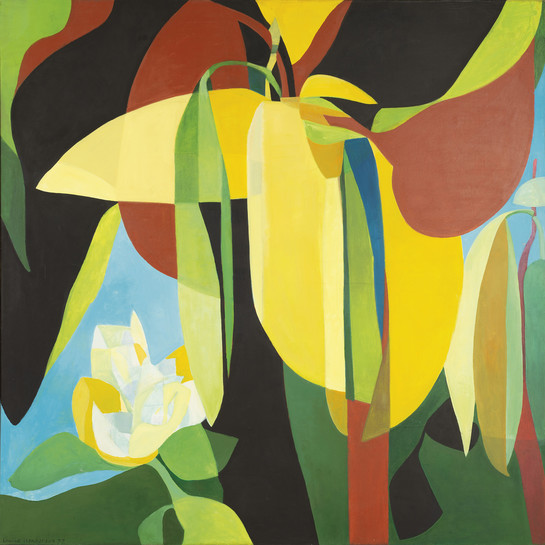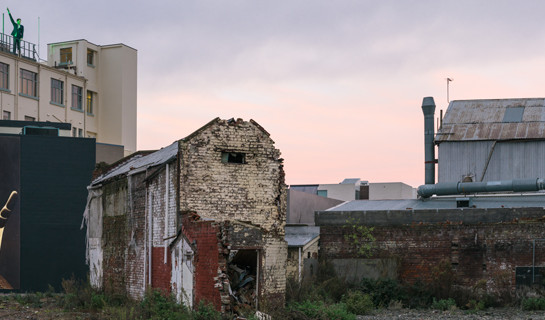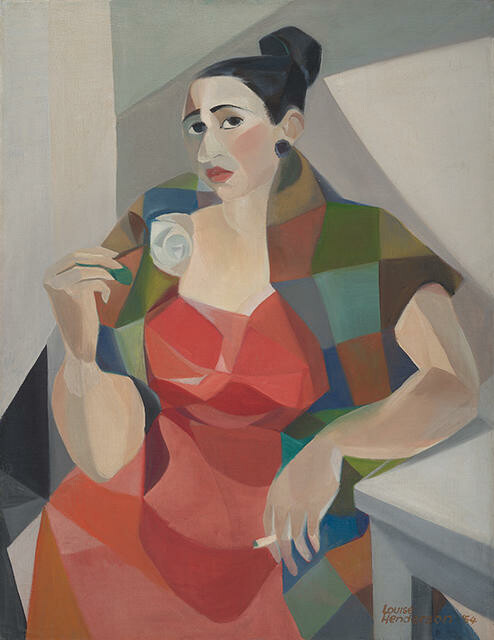Louise Henderson
France / Aotearoa New Zealand, b.1902, d.1994
Portrait of Betty Curnow
- 1954
- Oil on canvas
- Purchased, 1972
- 1035 x 830mm
- 72/65
Tags: cigarettes, Cubist, earrings (jewelry), flowers (plants), jewelry, people (agents), portraits, red (color), squares (geometric figures), tables (support furniture), women (female humans)
Artist Betty Curnow has been the subject of two powerful portraits in New Zealand art: one produced in 1942 by Rita Angus, the other the painting you see here. Henderson found Angus’s version too serious, and she was determined to present “the other side” of Curnow – specifically her “French side”. Dressing her in a glamorous red dress and colourful shawl, Henderson lets the fabric find Curnow’s curves. The resulting image – with its white rose and cigarette – is a spirited and theatrical protrayal of femininity. (Louise Henderson: From Life, 27 June – 11 October 2020)
Exhibition History
Brought to light, February 2010 – February 2011
Dressed in red, with a Spanish-inspired hairstyle and holding a cigarette and white rose, Betty Curnow is presented by Louise Henderson as the epitome of the independently-minded modern woman. Fractured, flattened forms suggest Henderson’s interest in synthetic cubism, pioneered by Pablo Picasso and Georges Braque, but Curnow remains recognisable and the force of her character provides much of the painting’s impact. Born in Paris, Henderson studied at the School of Industrial Arts before her marriage brought her to Christchurch in 1925. She taught in Christchurch and Wellington until 1950, then moved to Auckland and took up painting full-time, later teaching at art schools in Auckland and Sydney.
Betty Curnow, wife of poet Allen Curnow, was a friend whom Louise Henderson met during her time at Canterbury College in the 1930s. The Spanish hairstyle, flamboyant red dress, white rose and cigarette all suggest a woman of modernity and independence.
This portrait shows the influence of Cubism on Henderson. During 1952 she spent time studying under the French cubist painter, Jean Metzinger (1883 -1965) in Paris. The composition is reduced to fairly simple forms and treated as an arrangement of flattened planes, with a strong emphasis on the overall elements of design.
Louise Etiennette Sidonie Sauze was born in Paris and studied embroidery, lace design and drawing at the School of Industrial Arts. She married Hubert Henderson and came to Christchurch in 1925. She taught in Christchurch and Wellington until 1950, then moved to Auckland and took up painting fulltime. Henderson later taught at Elam School of Art in Auckland and Darlinghurst School of Art in Sydney. She was made a Dame in 1993.
Louise Henderson met Betty Curnow, wife of poet Allen Curnow, during her time at the Canterbury College School of Art in the 1930s. The Spanish hairstyle, flamboyant red dress, white rose and cigarette all suggest a modern, independent woman.
This portrait shows the influence of cubism on Henderson. During 1952 she spent time studying under the French cubist painter Jean Metzinger (1883–1965) in Paris. The composition is reduced to fairly simple forms and treated as an arrangement of flattened planes, with a strong emphasis on the overall elements of design.
Louise Etiennette Sidonie Sauze was born in Paris and studied embroidery, lace design and drawing at the School of Industrial Arts. She married Hubert Henderson and came to Christchurch in 1925. She taught in Christchurch and Wellington until 1950, then moved to Auckland and took up painting full time. Henderson later taught at the Elam School of Art, University of Auckland and Darlinghurst School of Art in Sydney. She was made a dame in 1993. (Label from 2005)


